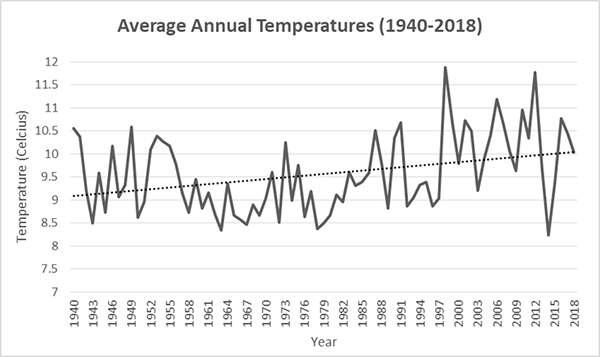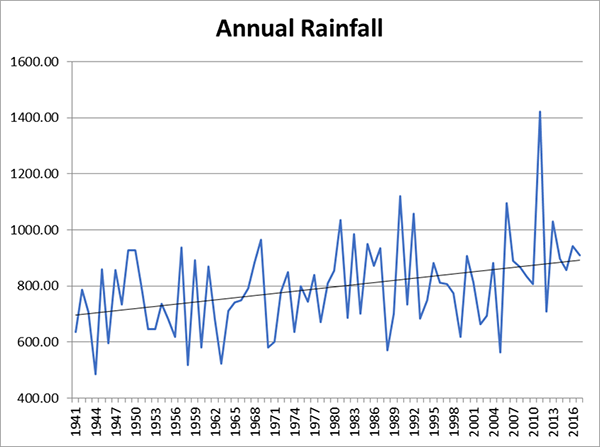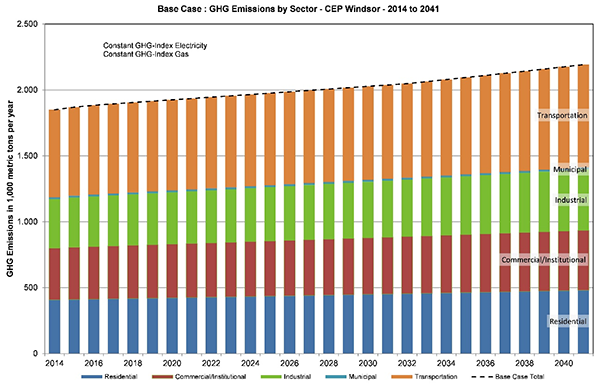Detroit River-Western Lake Erie Basin Indicator Project
Climate Change Adaptation in Windsor, Ontario
Authors
Karina Richters, Environmental Sustainability and Climate Change, Windsor, Ontario, krichters@citywindsor.caBackground
Regardless of the cause, the average temperature in Windsor has increased by almost 1°C since 1940. Scientists predict that by 2050, the average annual temperature in Ontario will increase by 2.5°C to 3.7°C from the 1961-1990 baseline average. This change, along with predictions that the number of “hot” days (over 30 °C/86 °F) in Windsor could almost quadruple by 2071-2100, is cause for concern. Heat related illnesses place a strain on our health care services and energy used to cool our buildings is expensive. In addition, this shift in the average weather for the region allows for the survival of invasive species and the expansion or introduction of insect vectors that carry disease.
As air temperature increases, so does the capacity of the air to hold more water. This can lead to more intense rainfall events, which Windsor has already experienced in recent years. In 2011, Windsor experienced the wettest year on record, measuring 1,568 mm of rain compared to the average annual rainfall of 844 mm. Increased temperature and intense rainfall events are two climate change impacts that have resulted in direct costs to Windsor residents through basement flooding and heat related illness expenses. Municipalities have a significant role to play in climate change adaptation as many climate change impacts will directly affect the services provided by the City of Windsor and our agencies.
Status and Trends
The Environment Canada weather station located at Windsor Airport has been monitoring and recording weather data since 1941. Since this time, the average annual temperature has increased by almost 1 °C (Figure 1).

Figure 1. Average annual temperature at the Windsor Airport as measured by Environment and Climate Change Canada, 1940-2018.
As air temperatures increases, so does the capacity of the air to hold more water leading to more intense rainfall events. Since 1970, there has been increasing evidence of heavier short duration (24 hours or less) rain events in southern Ontario.
Using the meteorological data obtained from the Windsor Airport station, an increasing trend in annual precipitation has also been documented (Figure 2). Based on a Canadian Climate Change Scenarios Network model (City of Windsor, 2012), precipitation is projected to increase, with winter and spring projected to get significantly wetter and a slight decline in the summer (Table 1). As noted above, these changes in our climate will result in an increase in heat-related illnesses, energy consumption, extreme precipitation events, flooding damage, and more.

Figure 2. Average annual precipitation (mm) in Windsor, 1941-2017.
Table 1. Mean annual precipitation projections for the City of Windsor, baseline period through 2080 (City of Windsor, 2018).


Adaptation Plan and Next Steps
As stated in the City of Windsor’s Environmental Master Plan, “the City of Windsor is committed to be a leader through its daily actions and services to enhance the environment for present and future generations” (City of Windsor, 2017a). This is shown through the commitment of City Council and City administration on the development of the 2012 Climate Change Adaptation Plan (City of Windsor, 2012). As one of the first municipalities in Ontario and Canada to undergo adaptation planning. Windsor has committed to building a more resilient and livable community.
The focus of the 2012 climate change adaptation plan is on the following five potential climate change impacts which were rated as posing substantial risk and therefore may result in the greatest impact on municipal operations:
- Increase in operating/maintenance demands to deal with climate extremes.
- Increased chance of flooding to basements, roads, and other infrastructure
- Increase in demand to all areas of operations when responding to an increase in severe storms (during and after).
- Increase in public health risks due to extreme heat.
- Implementation of development policies which were created in the absence of climate change considerations, which may increase our vulnerability.
- Mandatory downspout disconnection;
- Mandatory backwater valve installation;
- Enhance sewer maintenance and camera inspections;
- Consideration of additional off-line storage;
- Increase the use of flow restrictors on catch basins;
- Update the rainfall intensity duration frequency (IDF) curves;
- Seal manhole covers;
- Undertake public education on sewer use and wastewater treatment;
- Target education towards homeowners with suspected cross-connections;
- Use social media and other communication tools to warn public of the risk of basement flooding; and
- Enhance maintenance and inspection of road and sidewalks during snow or extreme weather events.
- Develop a green roof policy;
- Install rain gardens as pilot projects;
- Develop pilot projects for the use of porous pavement;
- Improve and enhance green space;
- Increase capital for shade structures;
- Increase heat education at community centers/pools; and
- Complete an urban heat island study.
- Develop clear policies for weather response; and
- Create an Extreme Weather Fund Reserve.
- Incorporate climate change adaptation into city policies and high-level plans;
- Create internal mechanisms to “ask the climate question” for all new major infrastructure projects;
- Monitor climate change, evaluate the effectiveness of adaptation strategies and adjust as needed (adaptive management);
- Use best available science to analyze how the climate is changing locally and how this may impact the community;
- Routinely review the City of Windsor’s vulnerability to climate change;
- Continuously conduct risk assessments to identify priority impacts requiring adaptation actions; and
- Engage the public, business, and other stakeholder groups.
In the summer of 2017, the Federation of Canadian Municipalities (FCM) issued a call for Climate Adaptation Partner Grants under the Municipalities for Climate Innovation Program (MCIP). International Council for Local Environmental Initiatives Canada submitted a successful grant application to undertake the Adaptation Changemakers project and solicited applications for municipalities to participate in the project. The purpose of the Adaptation Changemakers Project is to:
- Build capacity in the selected municipalities for integrating adaptation across the municipality and the wider community;
- Develop opportunities to collaborate with local stakeholders to carry out climate change vulnerability and risk assessments, prioritize impacts and develop a local community climate adaptation action plan; and
- Create a network of adaptive communities located within Ontario, British Columbia and Newfoundland.
To date, the Environment Sustainability and Climate Change Office has been working with City departments and the community to determine current and future climate change impacts, as well as carry out vulnerability and risk assessments for those impacts. The final goal of this project is to have a redeveloped Climate Change Adaptation Plan. The intent of the updated Climate Change Adaptation Plan is to identify the risks posed to the corporation, as well as to the community, and to identify adaptation actions that can be undertaken by the Corporation and the Windsor Community to reduce those risks. The actions taken today by the City of Windsor to proactively adapt to the changing climate will enhance community resilience to climate change, while reducing the human and economic costs of climate-related impacts. Adaptation actions can often lead to great cost savings as intense storm events and extreme heat can result in devastating expenses to repair infrastructure, mitigate basement flooding, and minimize health care costs.
Climate Change Mitigation in Windsor
In addition to adapting to the changing climate, the City of Windsor is taking steps to help the global effort to reduce greenhouse gas emissions. The City of Windsor has been tracking Corporate and Community emissions for a number of years. Greenhouse gas emissions are projected to continue to increase by approximately 22% from 2014 and 2041 (Figure 3).

Figure 3. Greenhouse gas (GHG) emissions in Windsor, 2014-2041.
The City of Windsor’s Community Energy Plan (2017) aims to create economic advantage, mitigate climate change, and improve energy performance. It strives to position Windsor as an energy center of excellence that boasts efficient, innovative, and reliable energy systems that contribute to the quality of life of residents and businesses (City of Windsor, 2017b).
The City of Windsor, through this plan, has set ambitious and transformative targets to support the global effort to keep global temperature increases within 1.5C. Through the implementation of the plan (City of Windsor (2017b) the Windsor Community will reduce per capita energy use and per capita CO2 emissions by 40% between 2014 and 2041.
References
- City of Windsor. 2012. Climate Change Adaptation Plan. Windsor, Ontario, Canada.
- City of Windsor. 2017a. Environmental Master Plan. Windsor, Ontario, Canada.
- City of Windsor. 2017b. Community Energy Plan. Windsor, Ontario, Canada.
- City of Windsor. 2018. Future climate projections. Windsor, Ontario, Canada.